The LG G3 Review
by Joshua Ho & Anand Lal Shimpi on July 4, 2014 5:00 AM EST- Posted in
- Smartphones
- LG
- Mobile
- Laptops
- G3
CPU Performance
By now, the Snapdragon 801 is mostly well-understood. It has four Krait 400 cores at either 2.26 or 2.45 GHz, an Adreno 330 at 578 MHz, a faster ISP, DSDA support, and higher clocks on the memory interface, along with support for eMMC 5.0 for faster NAND speed. However, OEM design choices can have significant effects on the relative performance of a device. For example, the Galaxy S5 trailed behind the HTC One (M8) despite a faster SoC due to worse thermal dissipation. This was because water resistance necessitated a new design that effectively encased the SoC in a polycarbonate cage, trapping heat in. The LG G3 has the same SoC and same build materials as the Galaxy S5, but the midframe is magnesium, not polycarbonate. This means that peak performance can be higher than the Galaxy S5.
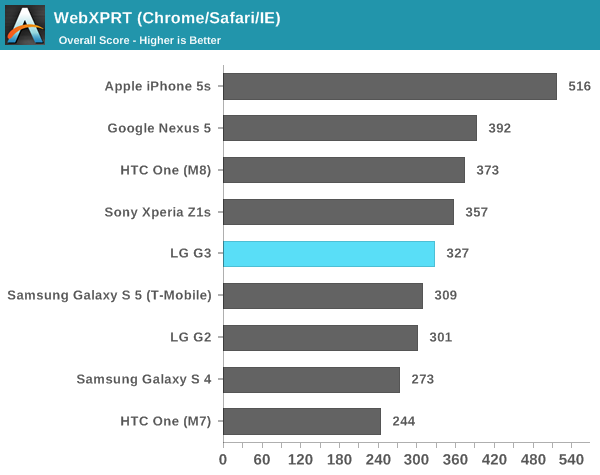
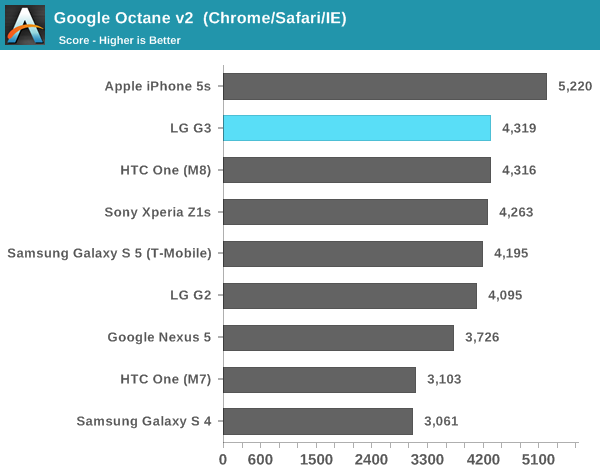
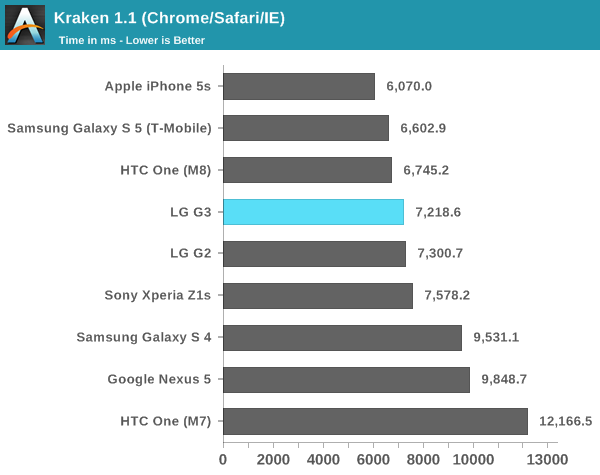
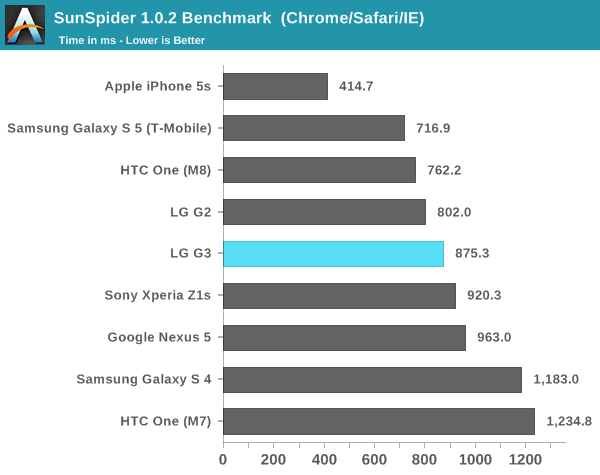
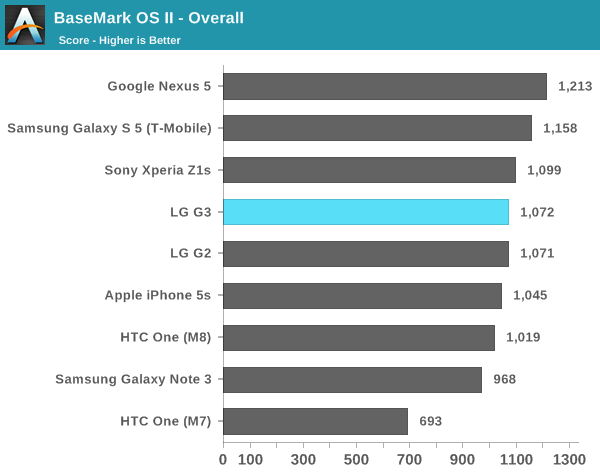
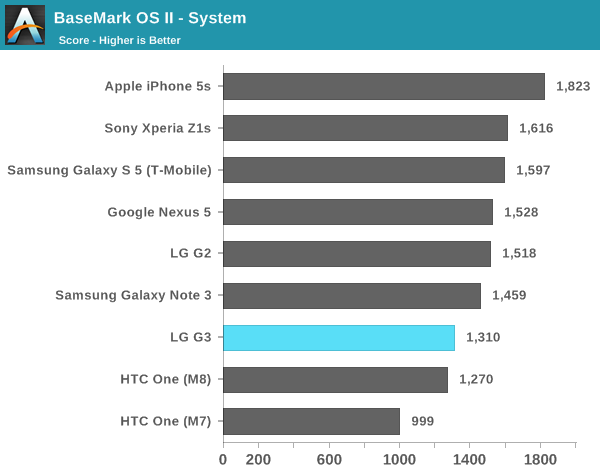
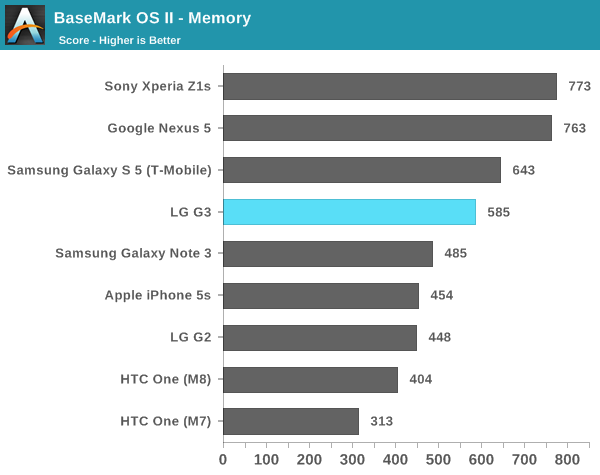

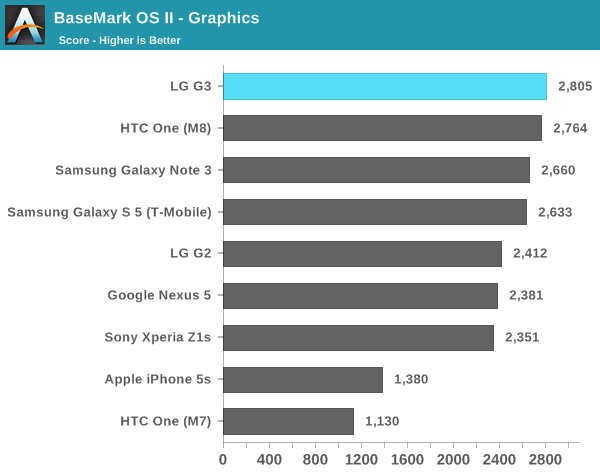
Relatively speaking, there's not much in the way of interesting things to talk about here, despite the new configuration. The G3 seems to trail the other S801 devices in web performance but it seems to depend upon the benchmark. This seems to be partially because of the G3's willingness to throttle, or because of the display's heat output. Either way, the trend is clear because of how often the display brightness is capped to 90 or 95 percent of the maximum to cool off the phone. When this isn't an issue though, the short benchmarks tend to show the faster performance of the G3.
GPU Performance
While the state of CPU benchmarking is heavily subject to difference in the performance of the web browser, things are a bit better in the GPU side. All Snapdragon 801 SoCs have the same GPU clocks, so this means that it'll be much easier to examine throttling behavior and reduce variability due to confounding factors.
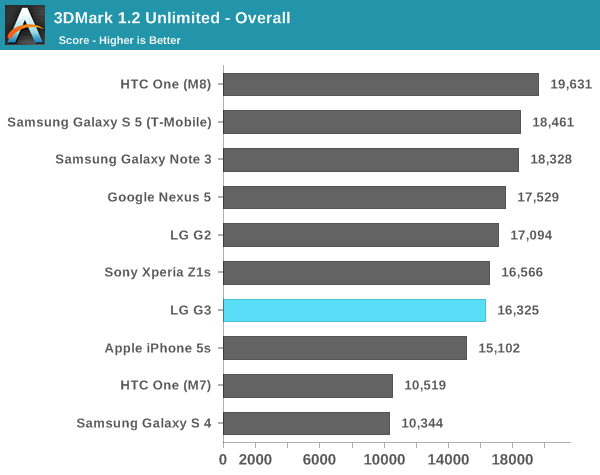
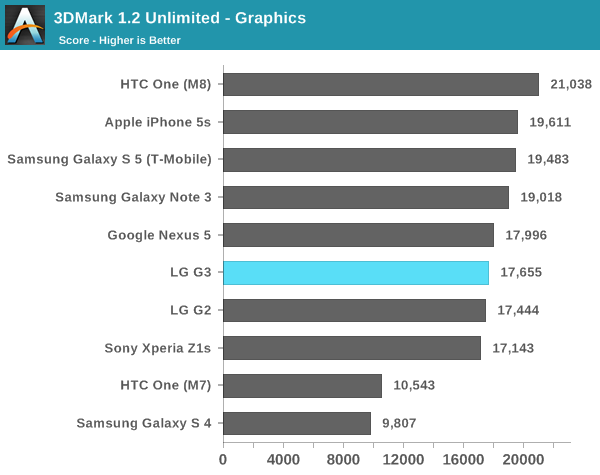

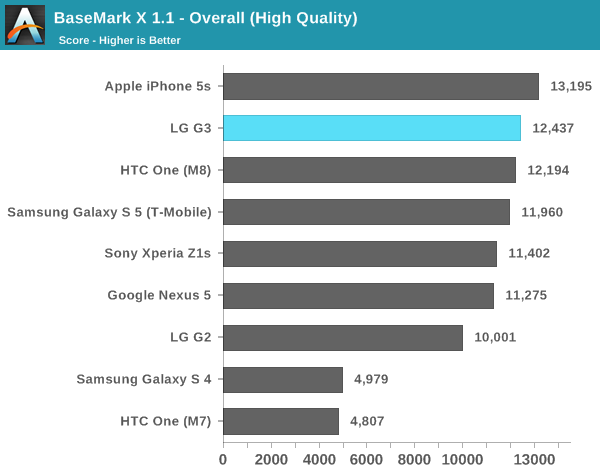
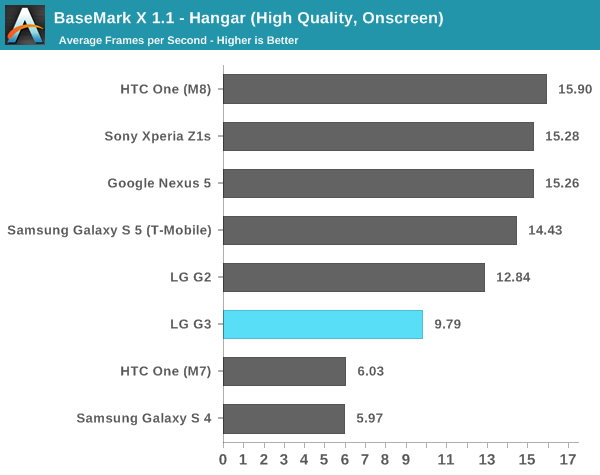
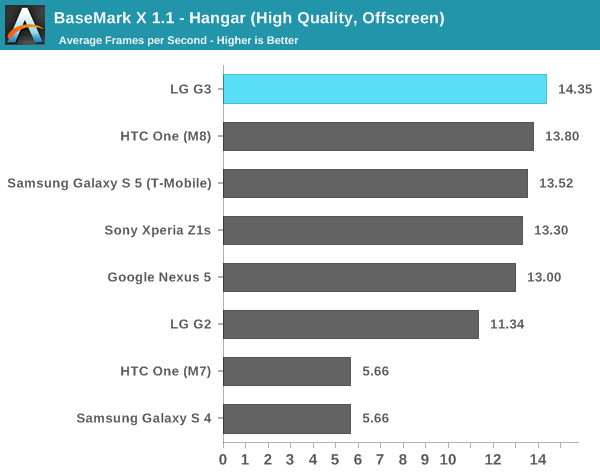
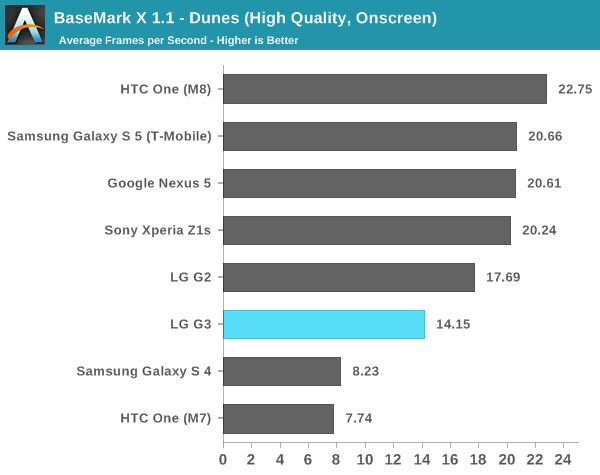
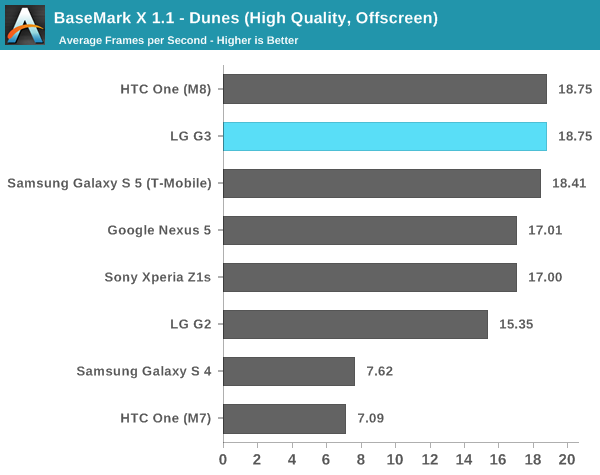
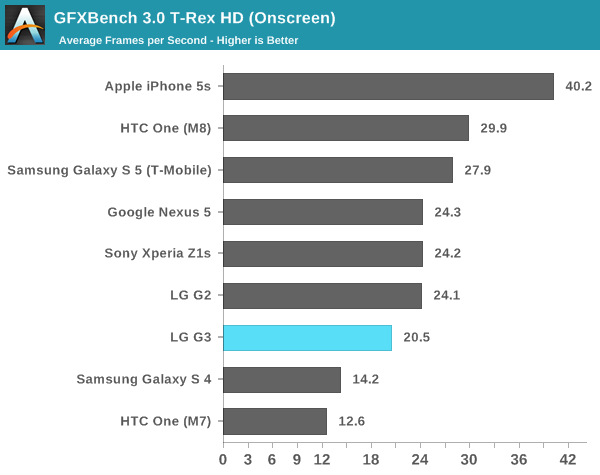
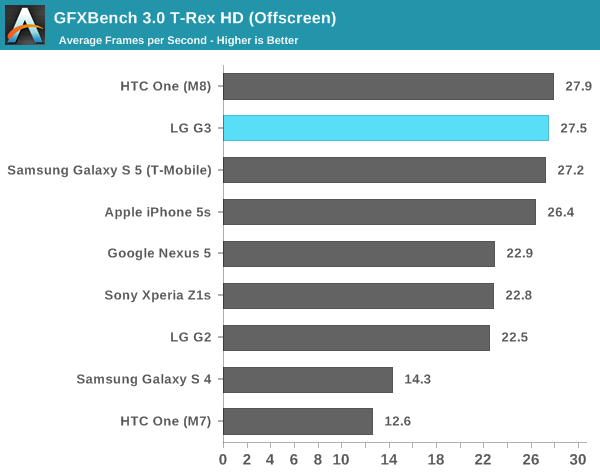
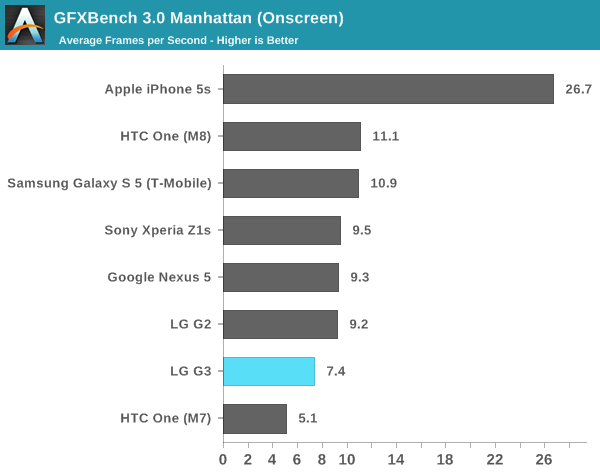
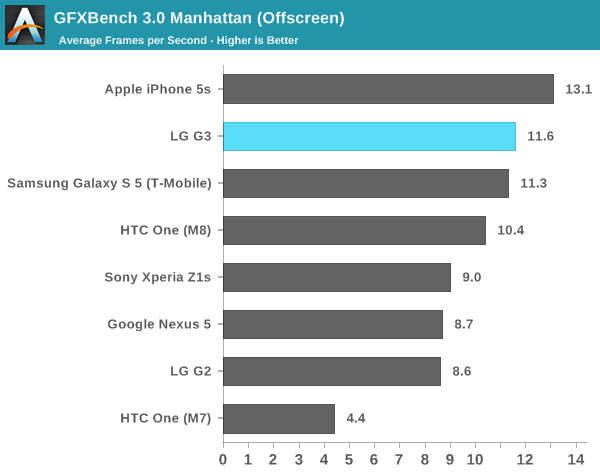
Here, we can see a noticeable trend. In the short tests, the LG G3 does great, easily nearing the top of the scores. However, 3DMark's extremely long-running test means that the G3 noticeably suffers in performance compared to the competition, and this is worsened by the G3's sinusoidal throttling patterns that cause significant degradation of performance for periods of time to balance out the high performance periods. On the on-screen tests, the G3 does worse than the high-end competition, which suggests that QHD/1440p truly does need Snapdragon 805's Adreno 420 in order to keep real-world performance from regressing relative to the Snapdragon 801, 1080p-screened counterparts.
NAND Performance
NAND performance used to be an afterthought, and effectively never discussed in most reviews. However, after the original Nexus 7 revealed the headaches that come with poor I/O performance this metric has increasingly come under greater scrutiny. To quantify this performance, we turn to Androbench with custom settings to evaluate Android smartphones.
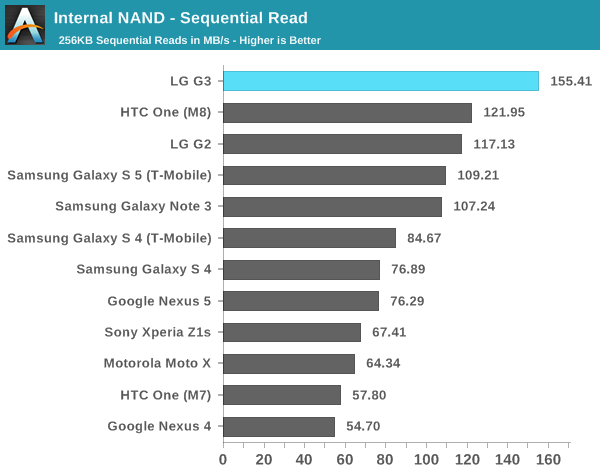
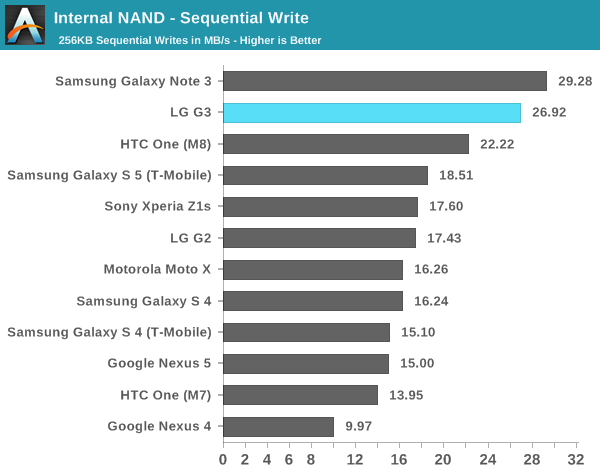
Here, the G3 is off to a great start. The sequential read speeds set new records and sequential write speeds are almost as good as it gets. This means that LG isn't cheaping out on NAND, which means that shooting 4K video and similarly intensive situations won't be a problem on the G3. However, random I/O performance is much more important as that's where people will notice poor performance in the form of stuttering and pauses.

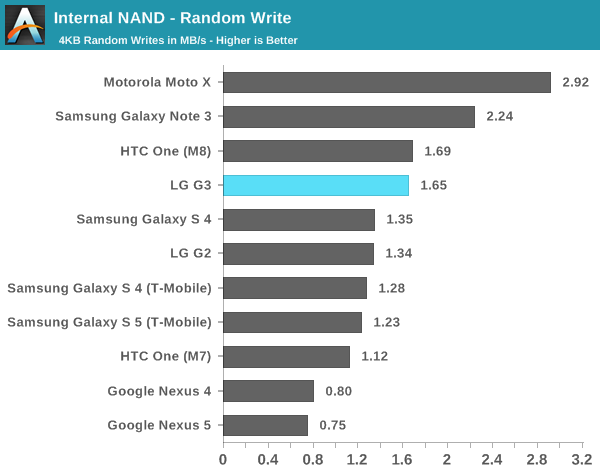
Here, we see a similar pattern. The LG G3 does great in random reads, but random write isn't quite as great. It's still perfectly usable and shouldn't present any problems for smoothness or general performance. The Moto X continues to hold its considerable lead here due to its F2FS file system that allows for much faster random I/O performance. Overall, the LG G3 shouldn't have any issues with I/O pauses, although you should still keep around 25% of your storage open to keep up I/O performance.










174 Comments
View All Comments
ZeDestructor - Sunday, July 6, 2014 - link
At normal view distances (15-30cm), I can see the pixel grid and aliasing on a 720p 4.3-4.7" screen :(.I'll move back to 4.x" once we get 420+ppi into the 4.3-4.7" segment.
ASEdouard - Saturday, July 5, 2014 - link
Aaah, didn't like the move to 1440p, but I feel there tradeoffs to get a 1080p display over a 480 800 are worth it. They look so much better.Homeles - Friday, July 4, 2014 - link
I actually have a huge struggle with getting the G2 to fit in my jeans, although that's mostly because of the case.Midwayman - Friday, July 11, 2014 - link
You must be wearing women's jeans.HarvesterX - Wednesday, September 3, 2014 - link
LG has been making the displays in iPod Touches as well as the newer iPhones. I agree a lower resolution would have been nicer and mainly why I stuck with my G2.My G2 performs just as well if not better (nodded of course) and all I'm really missing is that display, which I'm not actually missing one bit. Let's see what LF does with the G4 or by then I'll find another OEM (not Samsung)
Krysto - Friday, July 4, 2014 - link
I'm also disappointed to see nobody else has chosen the F2FS file system besides Motorola - not even Google in Android L, which is a real head-scratcher. Why could that be? Too much on their plate for L? They don't think it's quite ready yet? (it clearly seems to be on Motorola devices).It's weird they aren't racing to adopt it, when it gives nearly 2x performance in write speeds, for free.
ZeDestructor - Friday, July 4, 2014 - link
I suspect it's the same reason I'm still on ext4 rather than btrfs: they don't have enough faith in the FS just yet and want to see how it performs (especially wrt reliability) before committing to it, or it did something similar to what happened in my test of btrfs, it died and corrupted data.editorsorgtfo - Friday, July 4, 2014 - link
Somebody filed a bug for switching Android to F2FS:https://code.google.com/p/android-developer-previe...
You can vote by starring the issue.
ZeDestructor - Friday, July 4, 2014 - link
I see Z1s results in the graphs. Should we be expecting a review soon?piroroadkill - Friday, July 4, 2014 - link
Surely the Z2 is the current one to review. Z2 Compact when it hits will be the real star of the show, in my opinion.